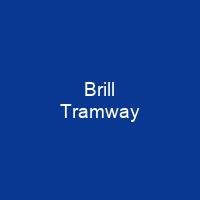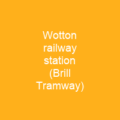The Brill Tramway: A Tale of Railways and Estates
Imagine stepping back in time to 1871, when the Brill Tramway, a six-mile rail line in Buckinghamshire, England, was privately built by the 3rd Duke of Buckingham. This railway wasn’t just any ordinary track; it was a horse tram line designed to transport goods between his lands and the national rail network. But why did he build this line? Wasn’t there already a functioning railway nearby?
The Birth of Brill Tramway
Local lobbying from the village of Brill led to an extension and conversion to passenger use in early 1872. The line was upgraded in 1894 but never extended to Oxford, instead being taken over by London’s Metropolitan Railway. This transition marked a significant shift in the railway’s purpose and operations.
From Goods to Passengers
The Brill Tramway started as a means of transporting goods efficiently between estates and the national rail network. However, it quickly evolved into something more: passenger services. The line was rebuilt in 1910 with faster locomotives but went into financial decline. By 1935, the infrastructure had been dismantled and sold, marking the end of an era.
The Marquess of Chandos and His Railways
Entrepreneur Sir Harry Verney opened the Aylesbury Railway in 1839, connecting it to the London and Birmingham Railway. The Wycombe Railway opened a branch to Aylesbury High Street railway station in 1863, leaving Aylesbury as the terminus of two small lines.
The Buckinghamshire Railway was being built by Sir Harry Verney, but its extension to Aylesbury was not completed. The Aylesbury and Buckingham Railway was incorporated in 1860 to connect the Buckinghamshire Railway to Aylesbury, with the Marquess of Chandos as chairman. This move set the stage for a series of interconnected railway ventures.
The Wotton Tramway
A small-scale agricultural railway was built to connect Wotton House estate to the railway, with permission from the Winwood Charity Trust. The line ran southwest from Quainton Road to Wotton near Wotton Underwood and split just west of the station at Wotton into sections running west to Wood Siding, a short stub to Church Siding in Wotton Underwood, and another section north to Kingswood.
Construction began on September 8, 1870, using cheap materials and winding around hills. Labourers were paid 11s per week and carried out the construction except laying the track. The line was built with longitudinal sleepers to reduce the risk of horses tripping.
The Challenges and Triumphs
Despite its humble beginnings, the Wotton Tramway faced numerous challenges. It opened on April 1, 1871, by the Duke of Buckingham. The section between Quainton Road and Wotton was initially unnamed but later referred to as ‘The Quainton Tramway.’ An extension from Wotton to Wood Siding was complete in June 1871.
A dedicated service from Quainton Road established, with three vans a week of milk shipped to London. A token system using colour-coded staffs ensured only one train could be on each section of the line. An excursion from Wood Siding to London ran on August 26, 1871, but was not successful due to weather and technical issues.
By 1894, the A&BR had been absorbed by the Metropolitan Railway (MR), which rebuilt and re-equipped the Tramway. They introduced new services and upgraded its route, reducing travel times from around 40 minutes to 32 minutes by 1931.
The Decline and Fall
Competition from trains and roads led to declining traffic on the Tramway. The London Passenger Transport Board took over the Oxford & Aylesbury Tramroad Company in 1935, confirming closure of the line. The last scheduled passenger service left Quainton Road on November 30, 1935.
The rails were ceremonially severed at midnight, marking the end of London Transport services. The infrastructure was sold at auction, raising £72 7s. The company ceased to exist in 1940, leaving behind a legacy of railway history and local lore.

The story of the Brill Tramway is a testament to the dynamic nature of railway history. From its humble beginnings as a private line to its eventual takeover and decline, it reflects the broader narrative of how railways shaped local communities and economies. Today, remnants of this once-thriving railway can still be found, serving as a reminder of a bygone era.
You want to know more about Brill Tramway?
This page is based on the article Brill Tramway published in Wikipedia (retrieved on December 5, 2024) and was automatically summarized using artificial intelligence.







